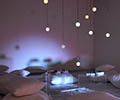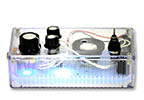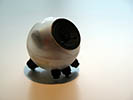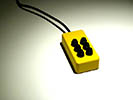

|

|

|

|
Jeremy Hight: Who are some of your influences?
Andrew Bucksbarg: Sorry, this answer is going to be a lot of lists. How about "who and what" for the question though? I would like to include concepts, other species, locations, events and inanimate objects as well. I am drawn to artists who cultivate different abilities, mentor or collaborate, use various means of art making or pollinate complex relationships with various audiences. Arts peoples like Tony Feher, Terry Riley, John Cage, Ellsworth Kelly, Cy Twombly, David Tudor, Félix González-Torres, Pauline Oliveros and Keith Harring.
Nuclear technology has an enormous impact on my work, as does diet. (I have been vegetarian and then vegan for quarter of a century). The dangerous and deadly unfolding of the contamination and fallout from Fukushima is constantly in my thoughts.
Some writer-thinkers who influence me are Donna Haraway, Huang Po, Susan Blackmore. What about these "whats"? Such influences are Calarts, Los Angeles, New York, cats, primates, bacteria and viruses, space, cooking, bodies of water from The Pacific to Lake Michigan.
I should also mention science in general, as well as theories of post humanism, emergence, consciousness, mind/brain, genetics/epigenetics, Buddhism, improvisation and social theory. The constant snowdrifts of street garbage in New York have been feeding into my fascination with plastic, as does the pacific garbage patch. I have been transforming plastic by chopping it, shredding it, etc. I make a lovely plastic bag chiffonade, which I would like to perform at some point.
JH: What are you working on right now?
AB: I am making installations that mix paint, light, sound/vibration, objects and the transformation of waste plastic. Some other projects include experimental EDM (electronic dance music), a psychedelic, synthesized and animated bird-song meditation video, my own custom noizical electronic instruments and related workshops and playful clothing designs.
JH: You have a fascinating range to your output as an artist. How would you describe your body of work?
AB: Maybe I am a fascinating fractal who partakes in arts excursions? Perhaps also white light and white noise, so far as the contents of all of these random frequencies and wavelengths of light reverberating through the autonomous, impulsive, creative-indulgent, process oriented and chaotically deliberate. I like a gentle participation with the world of the arts. Sometimes that means disengaging and intellectualizing the terms of my own practice. The person looking in and the person looking out see another place to be. I am not there or there. I also like collaborating and mentoring. I want that to have more credit.
JH: What relationships do you see between sound and form?
AB: Sound requires a vibrating source and matter through which those vibrations travel. Sound is the regular patterns of kinetic energy through matter. The absence of sound can only occur in a vacuum where there is no matter to propagate vibrations. We are always in the process of creating vibrations that spin off in space-time in a soup of movement. Let's think of these kinetic sound vibrations to another form of energy, light. We experience of the wavelengths of light we see absorbed and reflected off of the surfaces around us. Light from the sun is like an enormous speaker moving through the sky vibrating electro-magnetically. However, the actual sonic vibrations of the sun cannot travel through the vacuum of space. Scientists have come up with ways to listen though, you can listen (and watch) some of the solar oscillations here: solar-center.stanford.edu/singing/. We are both transducers and emitters of energy.
JH: Are there areas incorporating sound, objects and performance that you feel are open for interesting works, and maybe even new avenues and forms?
AB: Uncommon (or random) mixing is a means of innovation. It's good to recover past work and practices this way and make connections to others. I want to have a conversation with my situated experience of the world. I don't feel particularly sticky about describing my work based on an avenue of sense and perception, but we do don't we?
Layers are also great for new possibilities and exploring orders of magnitude: life within life or mechanisms/machines inside of machines. These are good techniques for emergence!
My effort is to foster an embodied, deliberate practice. Sometimes we might not have to reinvent the wheel, just understand in practice what has been done before. On the opposing end of this, it takes some extra work to familiarize yourself in vacations outside of your safe zone, but the antithesis of rigidity is an appealing reward. Balancing the reality that homo sapiens has come to art making with largely the same concerns, abilities and potential as all the artists before with this ideation of the new can be freeing. Why not get into the experience of it all?



 del.icio.us
del.icio.us


